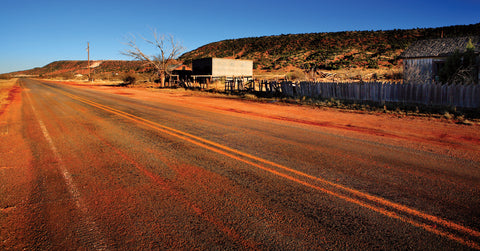
Ghost Towns: Cuervo, New Mexico
Even in the offbeat world of ghost towns Cuervo, New Mexico, stands apart. Unlike other ghosts, many of which sprouted up in remote places that spelled the community’s doom after residents’ livelihoods disappeared, Cuervo was and still is readily accessible. Though largely abandoned decades ago, the desert village remains in full view of I-40, along which thousands of vehicles speed every day. Curious visitors can take Exit 291 to a frontage road and then meander dirt roads through what remains of Cuervo. Even the railroad tracks that gave it life keep busy, trains rumbling by on schedule. Regardless, this once vibrant community seems destined to be a ghost town, though on at least two occasions it looked as if it might rally.
Schoolhouse No. 6 is made from the ubiquitous local red sandstone. (John
House)
Cuervo was founded in 1901 as a siding when the westering Chicago, Rock Island & Gulf Railroad extended its tracks from the Texas Panhandle into east-central New Mexico Territory. Cuervo (pronounced “CUHR-voh” by locals) is the Spanish word for raven, a ubiquitous bird in the region, though the roadrunner is the state bird. The CRI&G likely named it after one of two nearby hills—either 5,366-foot Cuervo Hill (9 miles to the northwest as the crow flies) or 4,984-foot Cuervito Peak (a mile northwest of town).
A post office opened in 1902, and the town took root when ranchers moved into the area around 1910. Not long after their arrival, however, the CRI&G abandoned the siding in favor of Tucumcari (40 miles to the east) and Santa Rosa (17 miles to the west). Any hope of growth as a cattle shipment point or supply hub was lost before Cuervo could become firmly established.
In 1926 road
crews laid down Route 66 through Cuervo, prompting merchants to lure passing
motorists with gas stations, hotels and stores.
Offered a lifeline when road crews laid Route 66 through the center of town in 1926, Cuervo added gas stations, hotels and stores to cater to passing motorists and two churches, two schools and two doctors to tend to residents. Its population peaked at 300 in the early 1940s, though there was little to recommend it—even less so in 1946 when travel writer Jack D. Rittenhouse dashed off this description in A Guide Book to Highway 66 : “Pop. 128…few gas stations; groceries; no cafe, garage or other tourist accommodations. A scant dozen dwellings comprise this small town.”
Another opportunity for rebirth beckoned from the horizon in the late 1960s as I-40 approached Cuervo. But the four-lane highway, with its broad median and shoulders, barreled through the middle of town like a bowling ball through pins, leaving the community split in two. By then the last school had closed, and most residents had moved on down the line.
“I have been to more than 70 ghost towns, and I have been to Cuervo four times,” says ghost town aficionado John M. Mulhouse, author of Abandoned New Mexico: Ghost Towns, Endangered Architecture and Hidden History. “It is the creepiest one I have been to. There are numerous reports of unsavory activity in the abandoned buildings. Cuervo is also different because it is relatively intact. There are lots of adobe houses still standing, but just a general lack of overall disturbance. It is particularly unusual because I-40 runs right through it. So does Route 66.”
The red sandstone Santo Niño de Atocha Catholic Church holds
occasional services. (Karen Schudson)
Yet amid this array of deserted buildings is a beacon of hope—the tidy red sandstone Santo Niño de Atocha Catholic Church, which still holds occasional services. A carved stone over the entryway records it was commissioned in April 1915 by P. Martinez, Vic Segura and Max Salas, the latter of whom built the church. Their names are a reminder Cuervo is certainly not a mirage and that hundreds of people once lived there. “The priest at St. Rose of Lima Catholic Church in Santa Rosa had me install a new roof about four years ago,” says Josh Pacheco, owner of Pacheco Construction & Trucking in Tucumcari.
It is difficult to imagine tiny Santo Niño would entice enough people to move back and resurrect the old homesteads. Yet despite having lost its post office in 2011, Cuervo still has a handful of residents and retains its own zip code—88417. WW
